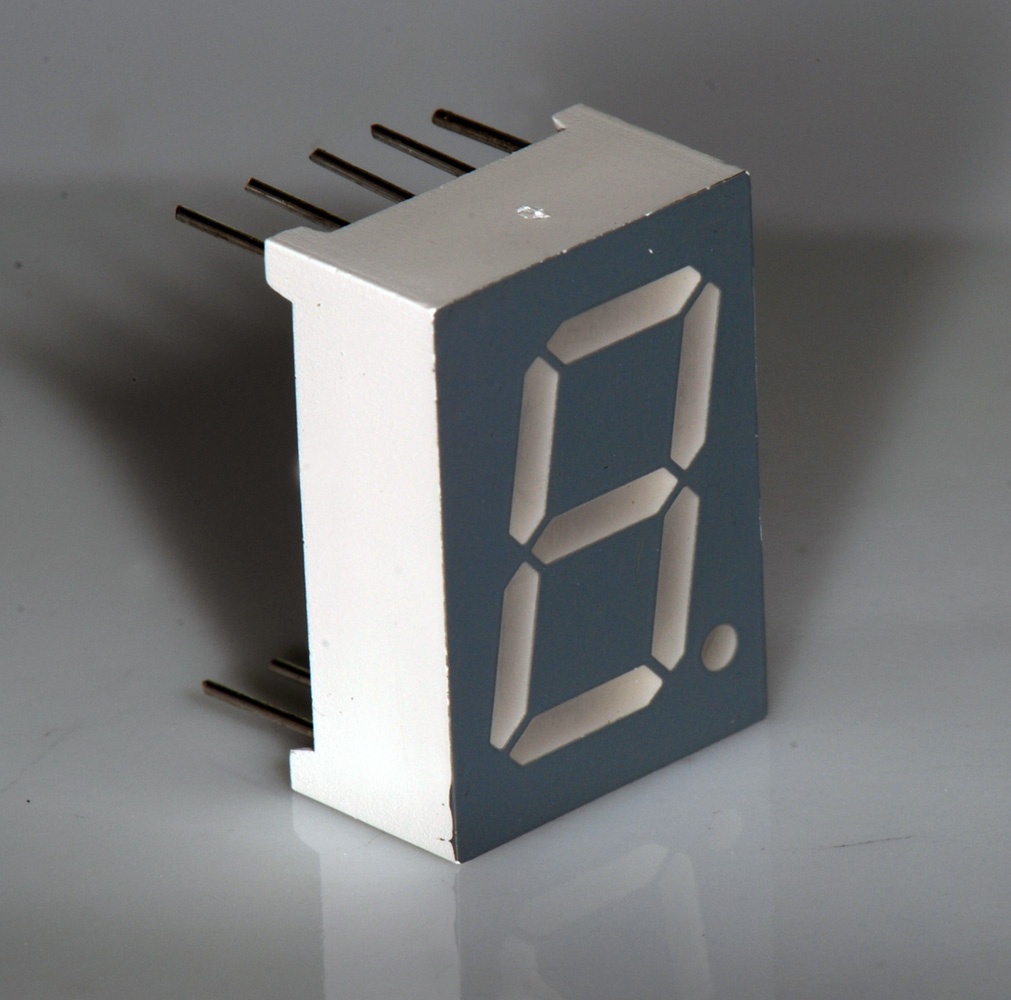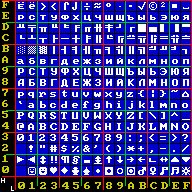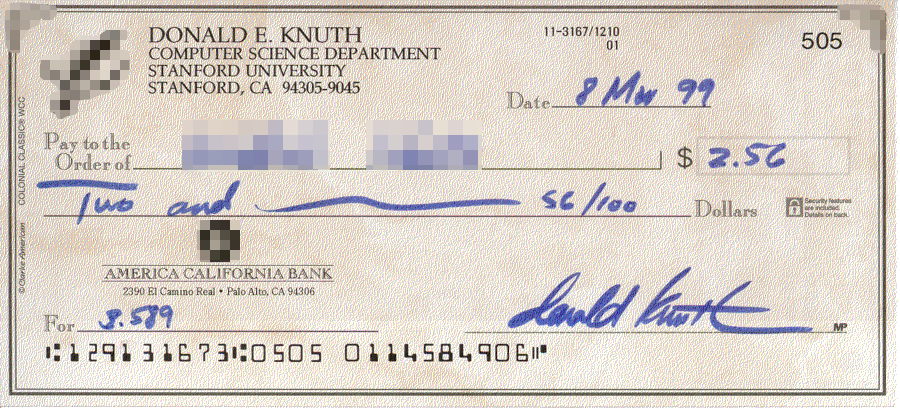|
Hexadecimal
In mathematics and computing, the hexadecimal (also base-16 or simply hex) numeral system is a positional numeral system that represents numbers using a radix (base) of 16. Unlike the decimal system representing numbers using 10 symbols, hexadecimal uses 16 distinct symbols, most often the symbols "0"–"9" to represent values 0 to 9, and "A"–"F" (or alternatively "a"–"f") to represent values from 10 to 15. Software developers and system designers widely use hexadecimal numbers because they provide a human-friendly representation of binary-coded values. Each hexadecimal digit represents four bits (binary digits), also known as a nibble (or nybble). For example, an 8-bit byte can have values ranging from 00000000 to 11111111 in binary form, which can be conveniently represented as 00 to FF in hexadecimal. In mathematics, a subscript is typically used to specify the base. For example, the decimal value would be expressed in hexadecimal as . In programming, a number of ... [...More Info...] [...Related Items...] OR: [Wikipedia] [Google] [Baidu] |
ASCII
ASCII ( ), abbreviated from American Standard Code for Information Interchange, is a character encoding standard for electronic communication. ASCII codes represent text in computers, telecommunications equipment, and other devices. Because of technical limitations of computer systems at the time it was invented, ASCII has just 128 code points, of which only 95 are , which severely limited its scope. All modern computer systems instead use Unicode, which has millions of code points, but the first 128 of these are the same as the ASCII set. The Internet Assigned Numbers Authority (IANA) prefers the name US-ASCII for this character encoding. ASCII is one of the List of IEEE milestones, IEEE milestones. Overview ASCII was developed from telegraph code. Its first commercial use was as a seven-bit teleprinter code promoted by Bell data services. Work on the ASCII standard began in May 1961, with the first meeting of the American Standards Association's (ASA) (now the American Nat ... [...More Info...] [...Related Items...] OR: [Wikipedia] [Google] [Baidu] |
Numeric Character Reference
A numeric character reference (NCR) is a common markup construct used in SGML and SGML-derived markup languages such as HTML and XML. It consists of a short sequence of characters that, in turn, represents a single character. Since WebSgml, XML and HTML 4, the code points of the Universal Character Set (UCS) of Unicode are used. NCRs are typically used in order to represent characters that are not directly encodable in a particular document (for example, because they are international characters that do not fit in the 8-bit character set being used, or because they have special syntactic meaning in the language). When the document is interpreted by a markup-aware reader, each NCR is treated as if it were the character it represents. Examples In SGML, HTML, and XML, the following are all valid numeric character references for the Greek capital letter Sigma In SGML, HTML, and XML, the following are all valid numeric character references for the Latin capital letter AE In SGML ... [...More Info...] [...Related Items...] OR: [Wikipedia] [Google] [Baidu] |
Seven-segment Display
A seven-segment display is a form of electronic display device for displaying decimal numerals that is an alternative to the more complex dot matrix displays. Seven-segment displays are widely used in digital clocks, electronic meters, basic calculators, and other electronic devices that display numerical information. History Seven-segment representation of figures can be found in patents as early as 1903 (in ), when Carl Kinsley invented a method of telegraphically transmitting letters and numbers and having them printed on tape in a segmented format. In 1908, F. W. Wood invented an 8-segment display, which displayed the number 4 using a diagonal bar (). In 1910, a seven-segment display illuminated by incandescent bulbs was used on a power-plant boiler room signal panel. They were also used to show the dialed telephone number to operators during the transition from manual to automatic telephone dialing. They did not achieve widespread use until the advent of LEDs in the 1970 ... [...More Info...] [...Related Items...] OR: [Wikipedia] [Google] [Baidu] |
Nibble
In computing, a nibble (occasionally nybble, nyble, or nybl to match the spelling of byte) is a four-bit aggregation, or half an octet. It is also known as half-byte or tetrade. In a networking or telecommunication context, the nibble is often called a semi-octet, quadbit, or quartet. A nibble has sixteen () possible values. A nibble can be represented by a single hexadecimal digit (–) and called a hex digit. A full byte (octet) is represented by two hexadecimal digits (–); therefore, it is common to display a byte of information as two nibbles. Sometimes the set of all 256-byte values is represented as a table, which gives easily readable hexadecimal codes for each value. Four-bit computer architectures use groups of four bits as their fundamental unit. Such architectures were used in early microprocessors, pocket calculators and pocket computers. They continue to be used in some microcontrollers. In this context, 4-bit groups were sometimes also called ''characters' ... [...More Info...] [...Related Items...] OR: [Wikipedia] [Google] [Baidu] |
Hex Dump
In computing, a hex dump is a hexadecimal view (on screen or paper) of computer data, from memory or from a computer file or storage device. Looking at a hex dump of data is usually done in the context of either debugging, reverse engineering or digital forensics. In a hex dump, each byte (8 bits) is represented as a two-digit hexadecimal number. Hex dumps are commonly organized into rows of 8 or 16 bytes, sometimes separated by whitespaces. Some hex dumps have the hexadecimal memory address at the beginning. Some common names for this program function are hexdump, hd, od, xxd and simply dump or even D. Samples A sample text file: 0123456789ABCDEF /* ********************************************** */ Table with TABs (09) 1 2 3 3.14 6.28 9.42 as displayed by Unix hexdump: 0000000 30 31 32 33 34 35 36 37 38 39 41 42 43 44 45 46 0000010 0a 2f 2a 20 2a 2a 2a 2a 2a 2a 2a 2a 2a 2a 2a 2a 0000020 2a 2a 2a 2a 2a 2a 2a 2a 2a 2a 2a 2a 2a 2a 2a 2a * 0000040 2a 2a 20 2a 2 ... [...More Info...] [...Related Items...] OR: [Wikipedia] [Google] [Baidu] |
Escape Character
In computing and telecommunication, an escape character is a character (computing), character that invokes an alternative interpretation on the following characters in a character sequence. An escape character is a particular case of metacharacters. Generally, the judgement of whether something is an escape character or not depends on the context. In the telecommunication Telecommunication is the transmission of information by various types of technologies over wire, radio, optical, or other electromagnetic systems. It has its origin in the desire of humans for communication over a distance greater than that fe ...s field, escape characters are used to indicate that the following characters are encoded differently. This is used to alter control characters that would otherwise be noticed and acted on by the underlying telecommunications hardware. In this context, the use of escape characters is often referred to as quoting. Definition An escape character may not have its o ... [...More Info...] [...Related Items...] OR: [Wikipedia] [Google] [Baidu] |
Radix
In a positional numeral system, the radix or base is the number of unique digits, including the digit zero, used to represent numbers. For example, for the decimal/denary system (the most common system in use today) the radix (base number) is ten, because it uses the ten digits from 0 through 9. In any standard positional numeral system, a number is conventionally written as with ''x'' as the string of digits and ''y'' as its base, although for base ten the subscript is usually assumed (and omitted, together with the pair of parentheses), as it is the most common way to express value. For example, (the decimal system is implied in the latter) and represents the number one hundred, while (100)2 (in the binary system with base 2) represents the number four. Etymology ''Radix'' is a Latin word for "root". ''Root'' can be considered a synonym for ''base,'' in the arithmetical sense. In numeral systems In the system with radix 13, for example, a string of digits such as 398 ... [...More Info...] [...Related Items...] OR: [Wikipedia] [Google] [Baidu] |
Printf
The printf format string is a control parameter used by a class of functions in the input/output libraries of C and many other programming languages. The string is written in a simple template language: characters are usually copied literally into the function's output, but format specifiers, which start with a character, indicate the location and method to translate a piece of data (such as a number) to characters. "printf" is the name of one of the main C output functions, and stands for "''print f''ormatted". printf format strings are complementary to scanf format strings, which provide formatted input (lexing aka. parsing). In both cases these provide simple functionality and fixed format compared to more sophisticated and flexible template engines or lexers/parsers, but are sufficient for many purposes. Many languages other than C copy the printf format string syntax closely or exactly in their own I/O functions. Mismatches between the format specifiers and type of ... [...More Info...] [...Related Items...] OR: [Wikipedia] [Google] [Baidu] |
Decimal
The decimal numeral system (also called the base-ten positional numeral system and denary or decanary) is the standard system for denoting integer and non-integer numbers. It is the extension to non-integer numbers of the Hindu–Arabic numeral system. The way of denoting numbers in the decimal system is often referred to as ''decimal notation''. A ''decimal numeral'' (also often just ''decimal'' or, less correctly, ''decimal number''), refers generally to the notation of a number in the decimal numeral system. Decimals may sometimes be identified by a decimal separator (usually "." or "," as in or ). ''Decimal'' may also refer specifically to the digits after the decimal separator, such as in " is the approximation of to ''two decimals''". Zero-digits after a decimal separator serve the purpose of signifying the precision of a value. The numbers that may be represented in the decimal system are the decimal fractions. That is, fractions of the form , where is an integer, and ... [...More Info...] [...Related Items...] OR: [Wikipedia] [Google] [Baidu] |
Character Encoding
Character encoding is the process of assigning numbers to Graphics, graphical character (computing), characters, especially the written characters of Language, human language, allowing them to be Data storage, stored, Data communication, transmitted, and Computing, transformed using Digital electronics, digital computers. The numerical values that make up a character encoding are known as "code points" and collectively comprise a "code space", a "code page", or a "Character Map (Windows), character map". Early character codes associated with the optical or electrical Telegraphy, telegraph could only represent a subset of the characters used in written languages, sometimes restricted to Letter case, upper case letters, Numeral system, numerals and some punctuation only. The low cost of digital representation of data in modern computer systems allows more elaborate character codes (such as Unicode) which represent most of the characters used in many written languages. Character enc ... [...More Info...] [...Related Items...] OR: [Wikipedia] [Google] [Baidu] |
Donald Knuth
Donald Ervin Knuth ( ; born January 10, 1938) is an American computer scientist, mathematician, and professor emeritus at Stanford University. He is the 1974 recipient of the ACM Turing Award, informally considered the Nobel Prize of computer science. Knuth has been called the "father of the analysis of algorithms". He is the author of the multi-volume work ''The Art of Computer Programming'' and contributed to the development of the rigorous analysis of the computational complexity of algorithms and systematized formal mathematical techniques for it. In the process, he also popularized the asymptotic notation. In addition to fundamental contributions in several branches of theoretical computer science, Knuth is the creator of the TeX computer typesetting system, the related METAFONT font definition language and rendering system, and the Computer Modern family of typefaces. As a writer and scholar, Knuth created the WEB and CWEB computer programming systems designed to encou ... [...More Info...] [...Related Items...] OR: [Wikipedia] [Google] [Baidu] |
Arabic Numerals
Arabic numerals are the ten numerical digits: , , , , , , , , and . They are the most commonly used symbols to write Decimal, decimal numbers. They are also used for writing numbers in other systems such as octal, and for writing identifiers such as computer symbols, trademarks, or license plates. The term often implies a decimal number, in particular when contrasted with Roman numerals. They are also called Western Arabic numerals, Ghubār numerals, Hindu-Arabic numerals, Western digits, Latin digits, or European digits. The ''Oxford English Dictionary'' differentiates them with the fully capitalized ''Arabic Numerals'' to refer to the Eastern Arabic numerals, Eastern digits. The term numbers or numerals or digits often implies only these symbols, however this can only be inferred from context. It was in the Algerian city of Béjaïa that the Italian people, Italian scholar Fibonacci first encountered the numerals; his work was crucial in making them known throughout Europe. ... [...More Info...] [...Related Items...] OR: [Wikipedia] [Google] [Baidu] |




